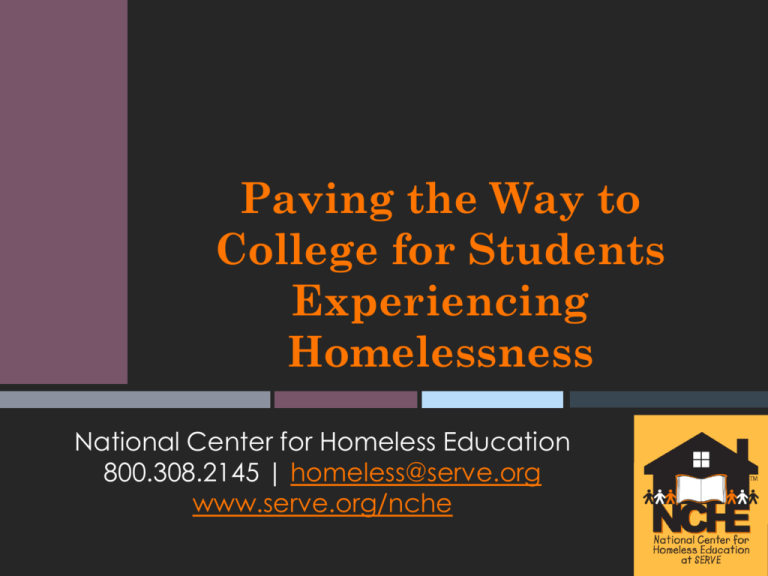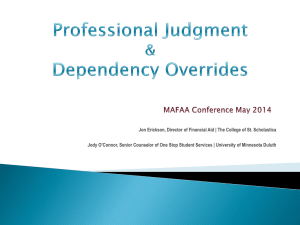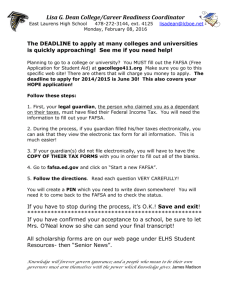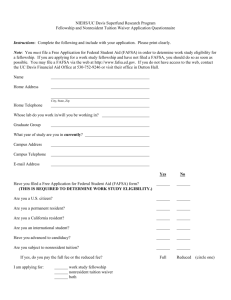Paving the Way to College for Students Experiencing
advertisement

Paving the Way to College for Students Experiencing Homelessness National Center for Homeless Education 800.308.2145 | homeless@serve.org www.serve.org/nche Get to Know NCHE… • NCHE operates the U.S. Department of Education’s homeless education technical assistance and information center • Website: www.serve.org/nche • Webinars: www.serve.org/nche/web/group.php • Helpline: 800-308-2145 or homeless@serve.org • Listserv: www.serve.org/nche/listserv.php • Products: www.serve.org/nche/products.php • Handouts: www.serve.org/nche/web/college.php On average, the lifetime earnings of someone with a Bachelor’s degree will almost double those of someone with a high school diploma Source: The College Payoff, https://cew.georgetown.edu/collegepayoff Session Outline • Dealing with application expenses • Advanced Placement exam fees • College entrance exam fees (SAT and ACT) • College application fees • Seeking financial aid and scholarships • The FAFSA for “accompanied” and unaccompanied homeless students • Private scholarships • State-specific opportunities • Options for undocumented homeless students Foundational Documents • The McKinney-Vento Act www.serve.org/nche/m-v.php • The FAFSA (Free Application for Federal Student Aid) www.fafsa.gov • The Application and Verification Guide (AVG) www.serve.org/nche/ibt/higher_ed.php • Webinar handouts .www.serve.org/nche/web/college.php AP test $91 ea ACT $54.50 per + + College application* $35-$50 ea = General SAT test $52.50 per SAT subject test $26/basic exam fee + $16 and up/exam ea Total range + + $225-$975 *The College Board recommends that students apply to between 5 and 8 colleges. College Admissions Checklist • Take Advanced Placement (AP) tests, if applicable • Take college entrance exam(s) (SAT and/or ACT) • Complete and submit college applications • Complete and submit the FAFSA • Complete and submit applications for private scholarships • More information: • “Applying 101”: https://bigfuture.collegeboard.org/getin/applying • “Financial Aid 101”: https://bigfuture.collegeboard.org/pay-forcollege/financial-aid Fee Waivers Advanced Placement (AP) Exams: • Most four-year colleges in the United States give students credit, advanced placement, or both on the basis of AP Exam scores; however • Each college or university may set its own policy as to which tests they will accept for credit, how much credit they will give, and what score is required to get credit. Advanced Placement (AP) Exams: • AP exam fee waivers are available for eligible students with no limit on the number of waivers per student • To qualify for an AP exam fee waiver: • The student receives or is eligible to receive free or reduced price lunch; • The student's family receives TANF assistance; or • The student is eligible to receive medical assistance under the Medicaid program Advanced Placement (AP) Exams: • Waivers are administered at the school; speak with your school’s AP Coordinator • Additional information is available at http://professionals.collegeboard.com/testing/ waivers/guidelines/ap College Entrance Exam: The ACT • To qualify for an ACT fee waiver, the student must: • Be enrolled in high school in the 11th or 12th grade • Be testing in the U.S., Puerto Rico, or a U.S. territory; or, if testing abroad, be a U.S. citizen • Meet one or more of the following indicators of economic need: • Student is receiving free/reduced lunch • Student is enrolled in TRIO. GEAR UP, or a similar program • Student lives in a foster home, is a ward of the state, or is experiencing homelessness • Family lives in subsidized housing or receives public assistance • Family income is below the USDA reduced-price lunch level College Entrance Exam: The ACT • Student can use the waiver to take the ACT up to two times • The waiver is sent to high schools each summer; students must access the waiver from the school counselor • The waiver covers the basic test fees, including sending the test score(s) to up to four colleges; does not cover late registration fees or change fees • Additional information is available at http://www.actstudent.org/faq/feewaiver.html http://www.act.org/aap/pdf/FeeWaiver.pdf College Entrance Exam: The SAT • To qualify for an SAT fee waiver, the student must: • Be enrolled in high school in the 11th or 12th grade (SAT) or in grades 9-12 (SAT Subject Tests) • Be testing in the U.S., Puerto Rico, or a U.S. territory; or, if testing abroad, be a U.S. citizen • Meet one or more indicator(s) of economic need (same as for the ACT fee waiver) College Entrance Exam: The SAT • The waiver must be obtained from the student’s high school counselor or an authorized agency • The student can receive up to four waiver cards: Up to two waivers for the SAT and two waivers for SAT Subject Tests (student may take up to three Subject Tests per test date) • The waiver covers the basic test fees, including sending the test score(s) to up to eight colleges (four standard; additional four with waiver); does not cover change fees, but now covers late registration fees • Additional information is available at http://sat.collegeboard.org/register/sat-fee-waivers College Application Fees • College Board program • Students who qualify for the College Board’s SAT fee waiver also qualify to receive up to four Request for Waiver of College Application Fee forms • Forms should be included with the students’ college applications and sent to colleges included in the SAT® Fee-Waiver Directory of Colleges at http://sat.collegeboard.org/SAT/public/pdf/sat-feewaiver-directory.pdf • Additional information is available at http://professionals.collegeboard.com/guidance/ap plications/fee-waivers College Application Fees • National Association of College Admission Counseling (NACAC) form • To be completed with the help of the high school counselor • For graduating high school seniors entering college in the fall • Same eligibility criteria as the ACT and SAT waivers • Can be based on income and/or the counselor’s knowledge of the family’s circumstances • Additional information is available at http://www.nacacnet.org/studentinfo/feewaiver/ Pages/default.aspx College Application Fees • Most colleges accept the College Board or NACAC waiver forms; however, individual institutions may have their own fee waiver policies that vary • Colleges that use The Common Application (https://www.commonapp.org/) accept the SAT college application fee waiver • Some colleges do not charge application fees for students that apply online • NCHE does not recommend using McKinney-Vento subgrant funds or Title IA set-aside funds to pay for AP exam, college entrance exam, or college application fees The FAFSA FAFSA Basics • FAFSA = Free Application for Federal Student Aid • The official FAFSA web address is www.fafsa.gov • Students applying for federal aid must complete a FAFSA for each school year for which they are seeking federal aid FAFSA Basics • A new FAFSA is released each January for the upcoming school year • Example: 2016-2017 FAFSA • Released in January 2016 • Valid for students attending school for Fall 2016 and Spring 2017 • Treatment of the Summer term depends on the school Calculation of Federal Aid • EFC = Expected Family Contribution • Based on the information submitted on the FAFSA, the U.S. Department of Education calculates the EFC • Dependent Student • Must report parent information on FAFSA • EFC is based on parents’ and student’s income and assets • Independent Student • Does NOT report parent information on FAFSA • EFC is based on student’s income and assets Who is Independent? • Independent if ANY of these are true: • • • • • • • • • • Married 24 years old Veteran or on active duty Graduate student Has a legal dependent (child/other) Orphan/Ward of the court/In a legal guardianship Legally emancipated minor In foster care at age 13 or older Unaccompanied homeless youth Independent by dependency override as determined by a financial aid administrator “Accompanied” Homeless Youth • Students experiencing homelessness with their family fill out the FAFSA as dependent students • Accompanied: In the physical custody of a parent or guardian • Homeless: Living arrangement meets the McKinneyVento definition of homeless “Accompanied” Homeless Youth • The EFC is based on family income and assets • Homeless students from low-income families likely will qualify for the maximum amount of federal aid • Example: The EFC Formula, 2016-2017 explains that dependent students who received free school meals in 2014 or 2015, and whose parents’ 2015 income is $25,000 or less, qualify for a $0 EFC • Additional information is available at https://www.ifap.ed.gov/efcformulaguide/attachmen ts/100615EFCFormulaGuide1617Attach.pdf Unaccompanied, Homeless, At-Risk • Unaccompanied homeless youth and unaccompanied youth at risk of homelessness fill out the FAFSA as independent students • Unaccompanied: Not in the physical custody of a parent or guardian • Homeless: Living arrangement meets the M-V definition of homeless • At risk of homelessness: When a student’s housing may cease to be fixed, regular, and adequate, for example, a student who is being evicted and has been unable to find fixed, regular, and adequate housing. Age Criteria • Youth: 23 or younger or still enrolled in high school on the date he/she signs the FAFSA • 21 or younger in outlined in statute • *NEW* 22 and 23 are included in a July 2015 US ED Dear Colleague Letter Age Criteria • July 2015 US ED Dear Colleague Letter http://ifap.ed.gov/dpcletters/attachments/GEN1516At tach.pdf “Applicants who are between the ages of 21 and 24 can who are unaccompanied and homeless or selfsupporting and at risk of being homeless qualify for a homeless youth determination, and will be considered independent students.” Reminder: This is in addition to students ages 21 or younger or still enrolled in high school on the date the FAFSA is signed, as outlined in statute. Determiners of Independent Status • Local homeless education liaison For students graduating from high school who were identified as an UHY while in high school • U.S. Department of Housing and Urban Development (HUD) shelter director or designee For students who have received services • Runaway and Homeless Youth Act (RHYA) shelter director or designee For students who have received services • Financial Aid Administrator (FAA) For any student, but particularly those who cannot get a determination from one of the other three authorized parties Determinations of independent student status for unaccompanied homeless youth on the 2014-2015 FAFSA 21,156 Local liaison 3,731 RHYA shelter 3,869 HUD shelter 1,737 FAA 30,864 TOTAL According to the AVG • If a student does not have, and cannot get, a determination from a local liaison, RHYA provider, or HUD provider, a FAA must make a determination of unaccompanied homeless youth status • If a student meets the definition of UHY, this is not a dependency override; this is determining the independent student status of an unaccompanied homeless youth According to the AVG • Verification of “yes” answers to the unaccompanied homeless youth questions on the FAFSA is not required unless there is conflicting information • A FAA may determine a student’s status with a documented interview According to the AVG • Encourages discretion and sensitivity when gathering information • Some information may be confidential (e.g., protected by doctor-patient privilege) • Child welfare and/or law enforcement reports are not necessary • Recommends consulting with local liaisons, State Coordinators, NCHE, school counselors, clergy, etc. 2016-2017 Online FAFSA • Online FAFSA includes four questions regarding unaccompanied homeless youth, including for youth who have no determination as of yet • Encourage UHY to complete the FAFSA online 2016-2017 PDF/Paper FAFSA • PDF FAFSA includes only 3 UHY-related questions 2016-2017 PDF/Paper FAFSA • A student without a determination of independent status must respond “no” to UHY questions and follow up with the FAA Tools • For local liaisons and shelters NAEHCY Template (Unaccompanied Homeless Youth Documentation of Independent Student Status for the FAFSA) available at http://www.naehcy.org/educationalresources/higher-ed • For financial aid administrators NCHE/NAEHCY FAA Tool (Making Student Status Determinations for Unaccompanied Homeless Youth: Eligibility Tool for Financial Aid Administrators) available at http://center.serve.org/nche/pr/faa_tool.php Scholarships, State Resources, and Undocumented Students Private Scholarships • Check with the high school’s guidance counselor for a list of private scholarships available to area students • The NAEHCY Education Fund Scholarship: http://www.naehcy.org/naehcy-scholarshipfund/about-the-fund • Give Us Your Poor/Horatio Alger Scholarship: https://scholars.horatioalger.org/ Private Scholarships • Free scholarship search engines: • Fastweb!: http://www.fastweb.com/ • College Board: https://bigfuture.collegeboard.org/scholarshi p-search • U.S. Department of Education: http://studentaid.ed.gov/types/grantsscholarships/finding-scholarships (includes scholarship search tips and guidelines) State Resources • Some states have special provisions available for lowincome and/or homeless students: • Indiana: Students receiving free lunch receive a tuition waiver when participating in Indiana’s Double Up Program (dual enrollment in college courses for students in 11th and 12th grade) http://www.in.gov/legislative/ic/code/title21/ar14/ch8.html • Florida: Homeless students are exempt from the payment of tuition and fees at a school district that provides postsecondary career programs, community college, or state university (2011 F.S. 1009.25) http://www.leg.state.fl.us/Statutes/index.cfm?App_mode=Displ ay_Statute&Search_String=&URL=10001099/1009/Sections/1009.25.html *restrictions apply Other Considerations • Encourage the student to consider a variety of institutions with different “price points” • A student may not be able to afford a particular institution, but other good college options may be available • A student may start at a community college and transfer to a four-year college at a later time, but needs to have a solid and informed transition plan • Consider housing options if looking into a school without dormitories Undocumented Students • Undocumented student • Not a U.S. citizen or legal permanent resident • Does not possess a green card, visa, or other legal documentation • Undocumented students may face obstacles in three areas: • College admission • Tuition • Financial aid College Admission • Access to higher education for undocumented students is highly state-specific and institution-specific • No federal law prohibiting the admission of undocumented students into U.S. colleges and universities • Some states permit the admission of undocumented students into state institutions • Some private institutions permit the admission of undocumented students • Some states or institutions admit undocumented students but treat them as out-of-state or foreign students, making them ineligible for state aid and in-state tuition College Tuition • Some states charge undocumented students out-of-state tuition fees • Some states permit undocumented students to pay in-state tuition under certain circumstances • Example: California permits undocumented students to pay in-state tuition if the student has attended a state high school for three or more years, has graduated from a state high school, and signs an affidavit promising to file an application to legalize his/her immigration status Financial Aid • Undocumented students are not eligible to receive federally funded financial aid • Undocumented students are not eligible for state aid in most states; a handful of states grant eligibility for state aid to undocumented students who qualify for in-state tuition • Private colleges and universities set their own financial aid policies; some grant scholarships and other aid to undocumented students • Many, but not all, private scholarships require applicants to be U.S. citizens or legal residents A Glance at the States • From Reconciling Federal, State, and Institutional Policies Determining Educational Access for Undocumented Students: Implications for Professional Practice, available at http://files.eric.ed.gov/fulltext/E D537525.pdf More Information • Visit http://professionals.collegeboard.com/guidan ce/financial-aid/undocumented-students for more information, including: • Information on state laws regarding college access for undocumented students • A list of scholarships available to all students, regardless of immigration status • Webinar handouts http://www.serve.org/nche/web/college.php • College Access and Success for Students Experiencing Homelessness: A Toolkit for Educators and Service Providers http://www.naehcy.org/educational-resources/he-toolkit • State Coordinator for Homeless Education contact information http://www.serve.org/nche/states/state_resources.php • Information about TRIO http://www2.ed.gov/about/offices/list/ope/trio/index.html • Information about GEAR UP http://www2.ed.gov/programs/gearup/index.html Additional Resources





